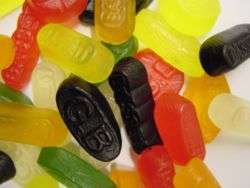Wine gum
Wine gums (or winegums) are chewy, firm pastille-type sweets similar to gumdrops without the sugar coating, originating from the United Kingdom. All brands have their own recipes containing various sweeteners, flavourings, and colourings. Wine gums are popular in the United Kingdom, Australia, Canada, Ireland, South Africa and many Commonwealth nations, as well as several European countries. Common brands include Maynards, Bassett's and Lion.
 An assortment of Bassett's wine gums. | |
| Type | Confectionery |
|---|---|
| Place of origin | United Kingdom |
| Created by | Charles Gordon Maynard |
| Invented | 1909 |
| Main ingredients | Gelatine, sugar, citric acid, Fruit flavouring |
The gums usually come in five shapes: kidney, crown, rhombus, circle and oblong, and are usually labelled with the name of a wine: for example, Maynard's use port, sherry, champagne, burgundy, and claret; other manufacturers may prefer different names such as rioja, merlot or rum.[1] Despite the name, they usually contain no alcohol. Depending on local laws or manufacturer's practices, packages may bear a specific statement that the candies "contain no wine."
History
Charles Riley Maynard started his business in 1880 by producing confections in a kitchen with his brother Tom in Stamford Hill, London, while his wife Sarah Ann served the customers. Maynard's sweets grew steadily and was launched as a company in 1896. Maynard's Wine Gums were introduced in 1909 by Maynard's son Charles Gordon Maynard. It took Charles Gordon Maynard some time to persuade his strict Methodist and teetotaller father that the sweets did not contain wine,[1] after which the father accepted that the candy was to be marketed as an alternative to alcohol.[2]
According to Cadbury, red and black are the most popular colours.[1] The red flavours are traditionally red berry, strawberry, or raspberry-flavoured in the United Kingdom and cherry in the United States. Black is traditionally blackcurrant flavoured. Limited edition dark-only wine gum issues have occurred, and in 2010, a limited "fruit duos" edition was produced with two colours and flavours on each gum.
See also
References
- "Maynards Factsheet". Cadbury UK. Archived from the original on 2012-01-03.CS1 maint: BOT: original-url status unknown (link)
- Bue Kindtler-Nielsen, ed. (2018). "Vem åt det första vingummit?" [Who ate the first wine gum?]. Världens Historia (in Swedish). No. 12. Bonnier Publications International. p. 74. ISSN 0806-4709.